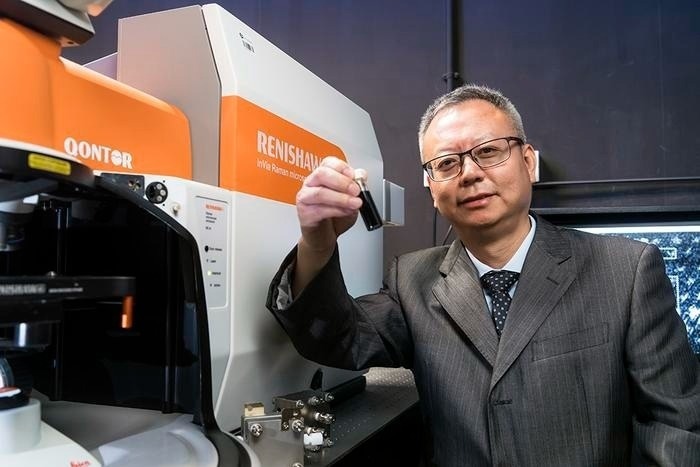A analysis workforce led by the Metropolis College of Hong Kong (CityU) has made an enormous breakthrough in nanomaterials analysis by efficiently setting up a extremely environment friendly electrocatalyst that may considerably enhance hydrogen manufacturing by electrochemical water splitting.

This vital invention has huge utility potentialities within the renewable vitality business.
Professor Zhang Hua, the Herman Hu Chair Professor of Nanomaterials at CityU, and his colleagues created an electrocatalyst using transition-metal dichalcogenide (TMD) nanosheets with uncommon crystal phases as helps. Within the electrocatalytic hydrogen evolution course of in acidic situations, the electrocatalyst confirmed excessive exercise and good stability.
Our analysis discovering is important within the sense that the hydrogen generated by electrochemical water splitting is thought to be some of the promising clear energies to switch fossil fuels within the close to future, decreasing environmental air pollution and the greenhouse impact.
Zhang Hua, Herman Hu Chair Professor, Nanomaterials, Metropolis College of Hong Kong
The research entitled “Part-dependent development of Pt on MoS2 for extremely environment friendly H2 evolution” was revealed within the journal Nature.
Professor Zhang believes growing extraordinarily efficient and steady catalysts is the important thing to electrocatalytic water-splitting analysis. It’s crucial to pick out applicable assist to optimize the exercise and stability of catalysts in the course of the course of.
TMD nanosheets have piqued the curiosity of researchers as an rising two-dimensional (2D) materials on account of their uncommon bodily and chemical options. It has been found that section is an important element in figuring out the traits and functionalities of TMD nanosheets.
Molybdenum disulfide (MoS2) with the usual 2H section, for instance, has a semiconductor property, however MoS2 with the atypical 1T or 1T’ section has a metallic or semi-metallic property, and so has robust conductivity.
Nevertheless, producing unconventional-phase TMD nanosheets with excessive section purity and high quality stays tough, and analysis into the affect of the TMD crystal section on the event of different supplies remains to be in its early phases.
Professor Zhang’s analysis group has efficiently generated a wide range of high-phase-purity and high-quality TMD crystal supplies with unconventional 1T′ section utilizing novel methods comparable to solid-gas reactions and salt-assisted synthesis. These nanomaterials have a excessive potential to be used in optoelectronic gadgets, catalysis, vitality storage, and superconductivity on account of their distinctive semi-metallic traits.
The researchers efficiently created a brand new technique for manufacturing TMD nanosheets with uncommon phases on this research. Additionally they regarded on the crystal section dependence of noble steel growth on 1T′-TMD and 2H-TMD nanosheets.
They found that using the normal 2H-TMD template permits for the epitaxial growth of platinum (Pt) nanoparticles, whereas the unorthodox 1T′-TMD template permits for creating single-atomically scattered Pt atoms (s-Pt). Primarily based on these outcomes, the researchers created a catalyst with single-atomically scattered Pt atoms/1T′ section molybdenum disulfide (s-Pt/1T′-MoS2).
The researchers used an improved floating electrode approach for testing to get past the mass transport constraint of Pt-based catalysts in electrocatalytic hydrogen evolution processes in acid media.
The s-Pt/1T′-MoS2 catalyst was found to have a excessive mass exercise of 85±23 A mgPt–1 at an overpotential of –50 mV and a mass-normalized change present density of (127 A mgPt–1) by way of their experimental findings. Moreover, the catalyst has nice utility potential by working steadily for 500 hours in a proton change membrane water electrolyzer.
The researchers confirmed that 1T′-TMD nanosheets might be efficient helps for catalysts by methodically analyzing the phase-dependent growth of noble metals on 1T′-TMD and 2H-TMD nanosheets.
The synthesized new electrocatalyst reveals superior exercise and glorious stability in electrocatalytic hydrogen evolution response in acidic media, and it’ll play a particularly essential position within the growth of fresh vitality sooner or later.
Dr. Shi Zhenyu, Research First Creator and Postdoctoral Researcher, Division of Chemistry, Metropolis College of Hong Kong
The research has broadened the definition of “Part Engineering of Nanomaterials” (PEN), opening up contemporary potentialities for the creation and synthesis of extraordinarily efficient catalysts. In response to Professor Zhang, the group will perform extra analysis on the 1T′-TMD-based catalyst and its potential for business use sooner or later to assist sustainable growth and clear vitality.
Professor Zhang and Professor Anthony R. J. Kucernak from the Division of Chemistry at Imperial School London are the corresponding authors. This research initiative demonstrated the worth of worldwide cooperation in creating scientific discoveries by bringing collectively collaborators from universities and analysis facilities in Hong Kong, mainland China, Singapore, and the UK.
Journal Reference:
Shi, Z., et al. (2023) Part-dependent development of Pt on MoS2 for extremely environment friendly H2 evolution. Nature. doi:10.1038/s41586-023-06339-3
Supply: https://www.cityu.edu.hk/

